Experimental Study on the Uplift Bearing Mechanism of New Pneumatic Pipe Piles
Abstract
1. Introduction
2. Experimental Section
2.1. Structure of the New Micropile
2.2. Field Test Design of the New Micropile
2.2.1. Test Site
2.2.2. Test Procedure
- (1)
- Drilling: A geological drilling rig with water drilling was used to create boreholes with a diameter of 146.0 mm. Mud was used to stabilize the borehole walls and prevent collapse.
- (2)
- Micropile assembly and installation: The small pneumatic device and anchorage components were installed inside the micropile. The micropile segments were connected via threaded joints. After drilling, the micropile was vertically lowered into the center of the borehole using the geological drilling rig. A centering bracket was welded at the top to ensure the steel-pipe micropile was securely and centrally installed.
- (3)
- Grouting: The pneumatic devices were regularly arranged inside the micropile, leaving sufficient space for grouting before the cylinders were activated. Grouting was performed intermittently from the bottom up using a grouting pipe. The grouting material was PC42.5R cement with a water–cement ratio of 0.5, and the grouting pressure was set at 1.0 MPa.
- (4)
- Ejection of anchorage components: The new micropile was placed into the borehole according to the predetermined anchorage positions. The air inlets of the small pneumatic devices were connected to the air compressor, and high-pressure gas was injected through the high-pressure inflation device to push the anchorage components into the soil.
- (5)
- Curing: After grouting and ejecting the anchorage components, the micropile was left to cure for 28 days. Sampling tests showed that the compressive strength after 28 days of curing ranged from 32.4 to 38.6 MPa.
- (6)
- Loading: The center of the jack base was aligned with the centroid of the test pile’s cross-section. The field test setup is shown in Appendix A. The load was applied incrementally at 0.1 times the predicted ultimate uplift capacity, with each load level maintained for 120 min until the test pile failed or further loading was impossible. The vertical displacement of the test pile was measured using two dial gauges with a range of 50 mm, symmetrically placed at the pile head, with a measurement accuracy of 0.01 mm.
2.2.3. Numerical Simulation and Calibration Methods
2.3. Selection of Microscopic Parameters and Model Construction
3. Results and Discussion
3.1. Indoor Test Results and Discussion
3.2. Field Test Results and Discussion
3.3. Micro-Parameter Calibration Results
3.4. Numerical Model Validation Results
3.5. Discussion of the Uplift Mechanism of the Novel Micropile
3.6. Influence of Anchorage Layout on the Ultimate Uplift Resistance of Micropiles
4. Conclusions
- The novel micropile integrates tightly with the grouting material and surrounding soil as a unified system through a linear anchoring component, significantly enhancing its performance. Field tests indicated that under ultimate conditions, its uplift resistance was improved by 161.7% compared to that of conventional micropiles, while displacement was reduced by 14.7%.
- A system of vertical and inclined force chains was formed around the anchoring component. By altering the stress distribution within the surrounding soil, the novel micropile converted part of the soil’s load-bearing mechanism under uplift forces from conventional vertical interface friction to a combination of anchoring component compression and micropile interface friction. This transformation significantly enhanced uplift resistance.
- Numerical simulations showed that without anchoring components, the ultimate uplift resistance of an 8 m long micropile was 489.9 kN. When the anchoring component was introduced with a reinforcement length of 1 m, the ultimate uplift resistance increased to 661.5 kN, representing a 35.0% improvement. When the anchoring reinforcement length was extended to 5 m, the ultimate uplift resistance of the novel micropile reached 1082.5 kN, marking a 121.0% increase.
- For an 8 m long micropile, every additional meter of anchoring length results in only a 5.7% increase in construction cost, yet the ultimate uplift resistance can be enhanced by more than 35%. This provides an effective treatment approach for addressing engineering challenges related to insufficient anchorage in soil slopes.
Author Contributions
Funding
Institutional Review Board Statement
Informed Consent Statement
Data Availability Statement
Conflicts of Interest
Appendix A

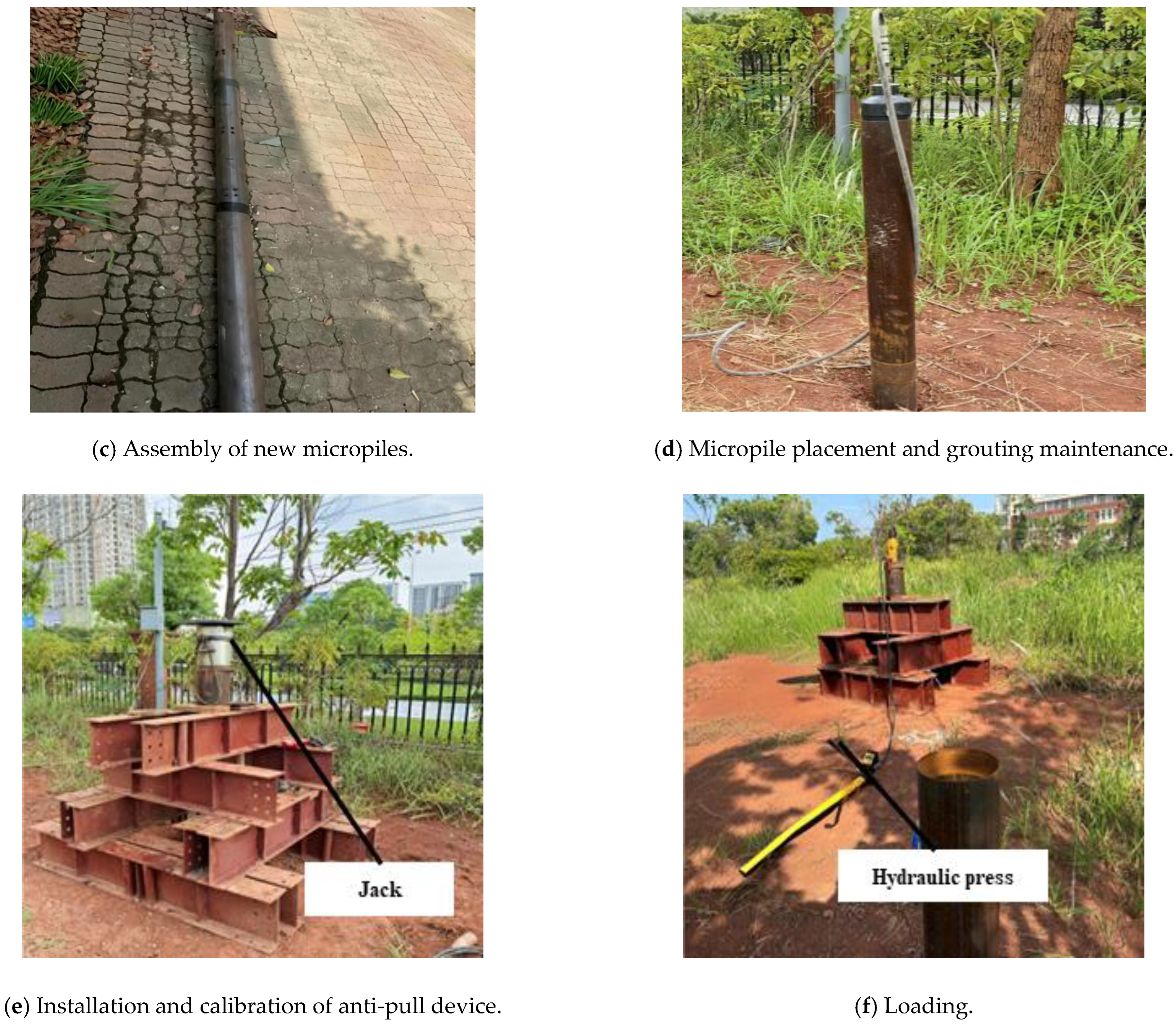
References
- Ye, W.; Kong, L.; Hu, R.; Zhao, F.; Shi, S.; Liu, Z. New prevention and treatment techniques and their applications to landslides and engineering slopes of expansive soils. Chin. J. Geotech. Eng. 2022, 44, 1295–1309. [Google Scholar] [CrossRef]
- Liu, P.; Wang, M.; Zhang, S.; Zhang, Y.; Wang, D.; Li, D. Macro and micro analysis of influence mechanism of anti-slide pile position on slope stability. J. China Foreign Highw. 2023, 43, 37–41. [Google Scholar]
- Cerfontaine, B.; Knappett, J.A.; Brown, M.J.; Bradshaw, A.S. Effect of soil deformability on the failure mechanism of shallow plate or screw anchors in sand. Comput. Geotech. 2019, 109, 34–45. [Google Scholar] [CrossRef]
- Wang, Y.; Hu, Y.; Zhang, R. Study on Treatment Method of Expansive Soil Embankment in Expressway Reconstruction and Extension. J. China Foreign Highw. 2024, 44, 1–8. [Google Scholar]
- Peng, N.; Gao, H.; Lv, W. Study on Rainfall Warning Standard for Abandoned Soil Site Slope Stability and Relative Coupling Treatment of Anchorage and Drainage. J. China Foreign Highw. 2022, 42, 7–14. [Google Scholar]
- Zhang, R.; Zhang, X.; Luo, H.; Yu, L.; Liu, Z. Research on the effect of dynamic regulation of prestressed micro-piles on the upheave of soft rock roadbeds. J. Railw. Sci. Eng. 2025, 7, 1–12. [Google Scholar] [CrossRef]
- Jiang, M.; Chen, E.; Liu, Y.; Zhu, Y.; Jiang, W.; Xie, R. Model Test on Soil Deformation Mechanism and Damage Mode Caused by Mud Leakage from Drilled Piles in Karst Area. J. China Foreign Highw. 2024, 44, 59–64. [Google Scholar]
- Chen, J.; Hagan, P.C.; Saydam, S. Shear behaviour of a cement grout tested in the direct shear test. Constr. Build. Mater. 2018, 166, 271–279. [Google Scholar] [CrossRef]
- Shawky, O.; Altahrany, A.I.; Elmeligy, M. Improved Pile Geometry to Reduce Negative Skin Friction on Single Driven Pile and Pile Groups Subjected to Lateral Loads. Geotech. Geol. Eng. 2022, 40, 4487–4516. [Google Scholar] [CrossRef]
- Wang, Y.; Xiong, Z.Q.; Wang, C.; Su, C.D.; Li, X.F. Research on the Reasonable Grouting Strength of Rock-Like Samples in Different Strengths. Materials 2020, 13, 3161. [Google Scholar] [CrossRef]
- Xiong, Q.; Yan, C.; Jiang, C.; Wamg, Y.; Xue, Z. Field test of automatic monitoring of PHC piles for reinforcement of wet and soft loess foundation based on internet of things technology. J. Eng. Geol. 2024, 32, 275–284. [Google Scholar] [CrossRef]
- Wang, X.-Q.; Yang, J.-J.; Wang, M.; Su, X.; Jiao, D.; Dong, M. The depth and prediction of cement soil degradation caused by the change of site environment. Period. Ocean Univ. China 2019, 49, 102–110. [Google Scholar]
- Wonglert, A.; Jongpradist, P.; Jamsawang, P. Bearing capacity and failure behaviors of floating stiffened deep cement mixing columns under axial load. Soils Found. 2018, 58, 446–461. [Google Scholar] [CrossRef]
- Bradshaw, A.S.; Cullen, L.; Miller, Z. Field study of group effects on the pullout capacity of “deep” helical piles in sand. Can. Geotech. J. 2022, 59, 538–545. [Google Scholar] [CrossRef]
- Chen, Y.; Wu, W.; Zi, F.; Geng, F.; Wang, W.; Zhao, Y. Study on the bearing characteristics of belled pile under combined H-U load in loess soil. J. Basic Sci. Eng. 2024, 32, 972–983. [Google Scholar] [CrossRef]
- Zhang, W.; Li, Y.; Goh, A.T.C.; Zhang, R. Numerical study of the performance of jet grout piles for braced excavations in soft clay. Comput. Geotech. 2020, 124, 103631. [Google Scholar] [CrossRef]
- Cerfontaine, B.; Knappett, J.; Brown, M.; Bradshaw, A. Design of plate and screw anchors in dense sand: Failure mechanism, capacity and deformation. E3s Web Conf. 2019, 92, 16010. [Google Scholar] [CrossRef]
- Sabri, M.; Vatin, N.; Ponomarev, A.; Nurmukhametov, R.R.; Kostyukov, I.I. Settlement of Soil Reinforced with Vertical Fiberglass Micro-Piles. Materials 2022, 15, 4744. [Google Scholar] [CrossRef]
- Sun, S.; Zhang, K.; Zhu, B. Method for analysis of micropile ultimate resistance in soil slope stabilization. China J. Highw. Transp. 2018, 31, 115–123. [Google Scholar] [CrossRef]
- Luo, H.; Zhang, R.; Nie, R.; Liu, Z. Experimental study on compressive bearing characteristics of micro-steel-pipe piles in red-bed soft rock. China J. Highw. Transp. 2022, 35, 97–106. [Google Scholar] [CrossRef]
- Ma, P.; Rui, R.; Cao, X.; Nie, R.; Wang, J.; Ding, R.; Sun, T. Model tests of micropile-reinforced soil slope with long and gently inclined fissures. Rock Soil Mech. 2023, 44, 1695–1707. [Google Scholar] [CrossRef]
- Ma, Z.; Lu, K.; Song, D.; Liu, W.; Wang, Y.; Li, S. Study on Compaction Characteristics and Compaction Process of an Unsaturated Silt Based on PFC3D. Appl. Sci. 2023, 13, 5547. [Google Scholar] [CrossRef]
- Wang, R.; Cheng, J.; Li, Z.; Qi, Y.; Gao, L.; Wang, M.; Ding, B. Experimental study and numerical analysis of rail heave on ballastless track induced by subgrade swelling. J. Railw. Sci. Eng. 2021, 18, 1696–1705. [Google Scholar] [CrossRef]
- Shi, C.; Zhang, Q.; Wang, S. Numerical Simulation Technology and Application with Particle Flow Code (PFC 5.0); China Architecture & Building Press: Beijing, China, 2018. [Google Scholar]
- China Academy of Building Research. Technical Code for Testing of Building Foundation Piles: JGJ 106-2014; China Architecture & Building Press: Beijing, China, 2014. [Google Scholar]
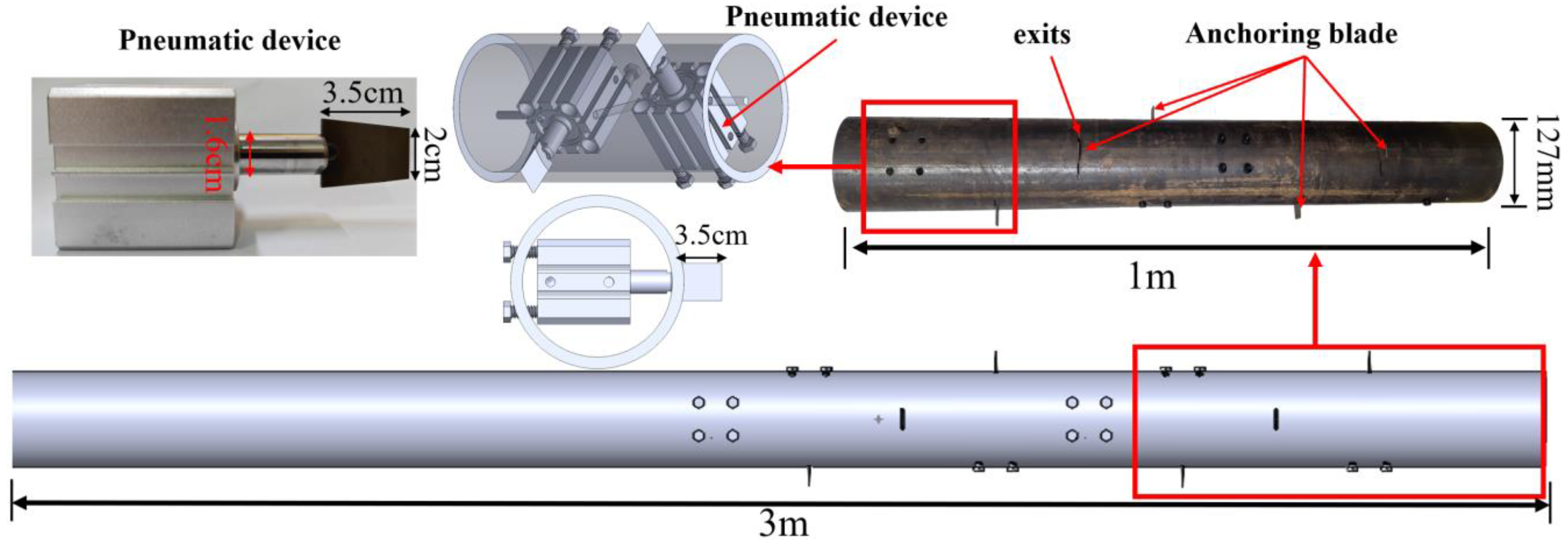
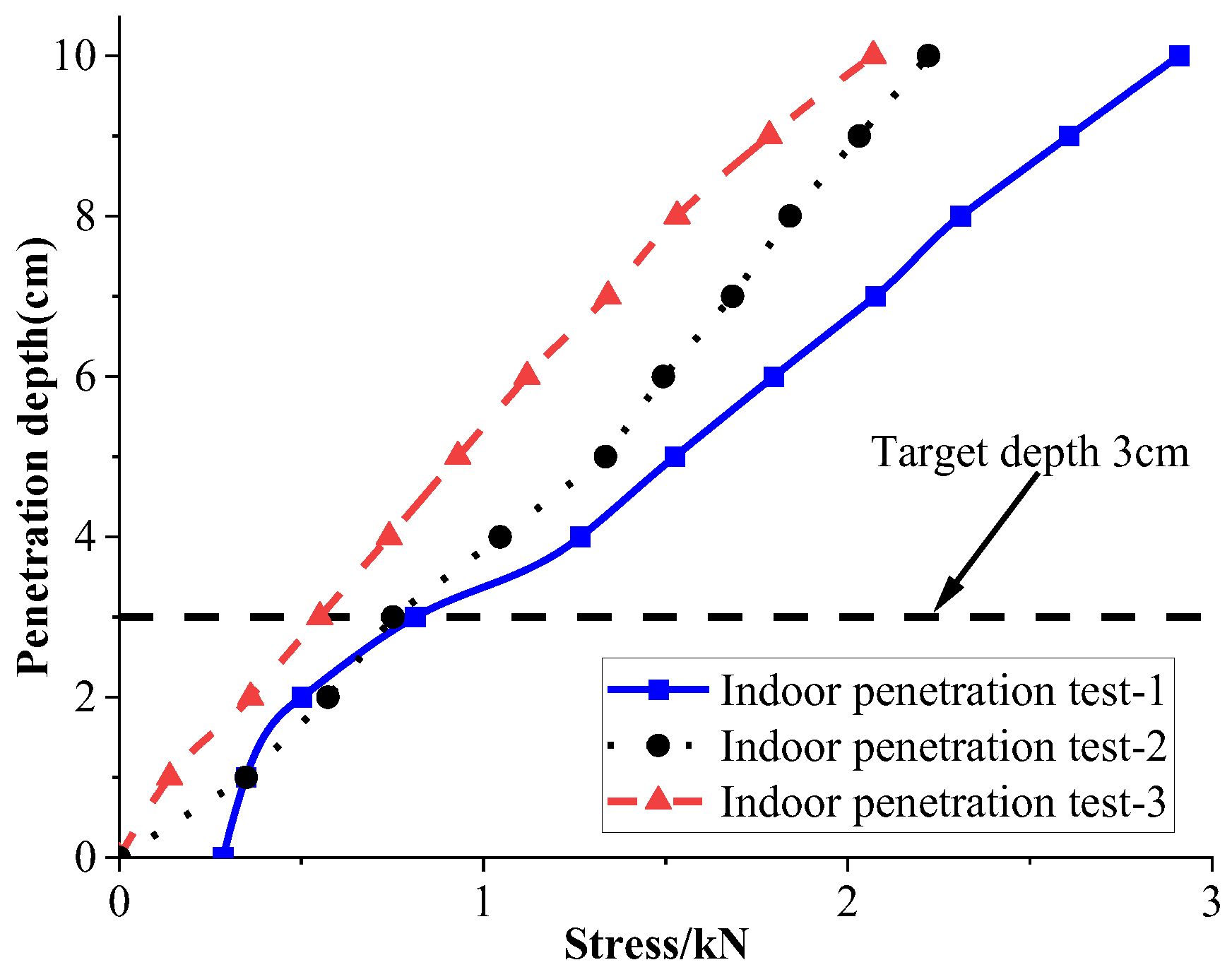



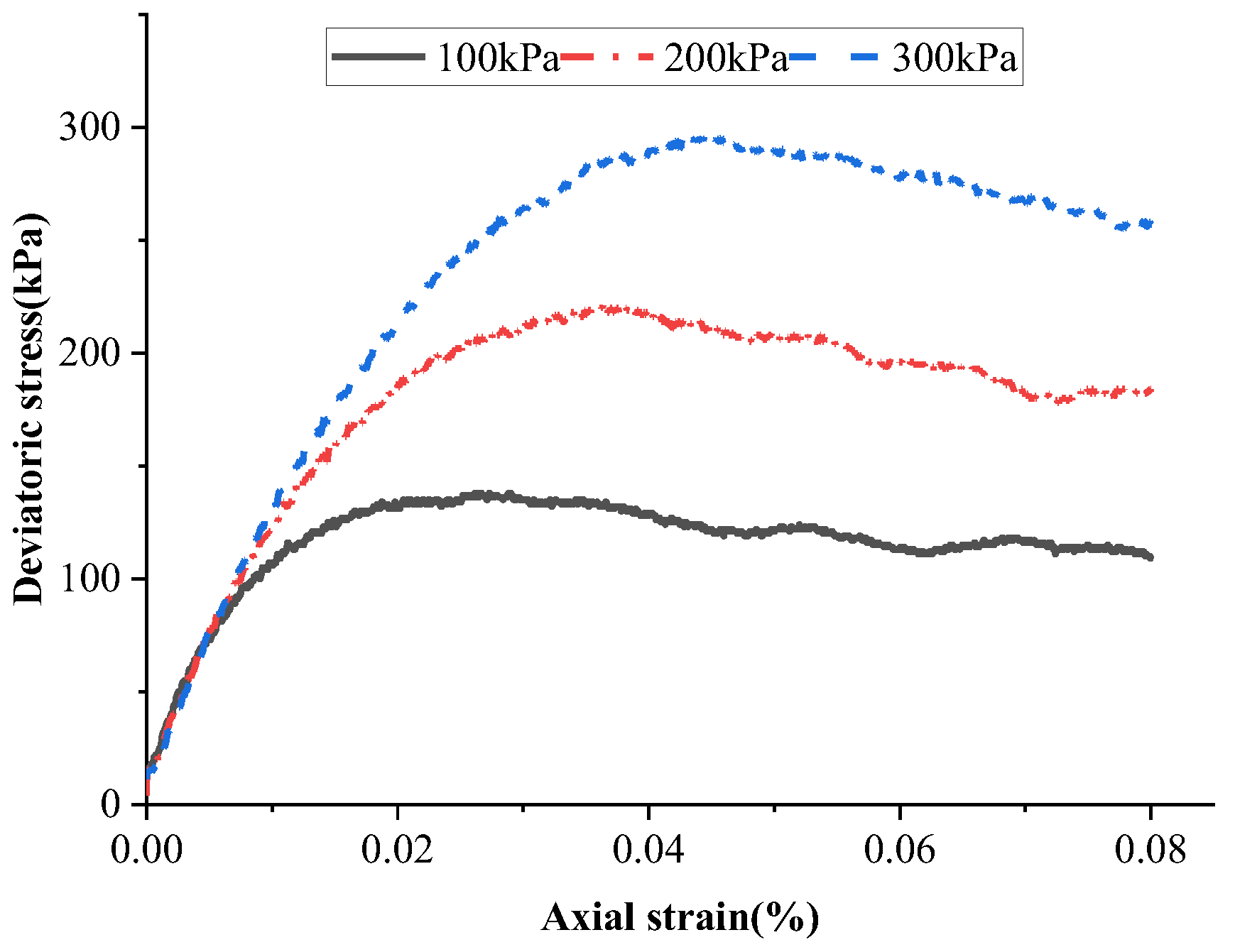
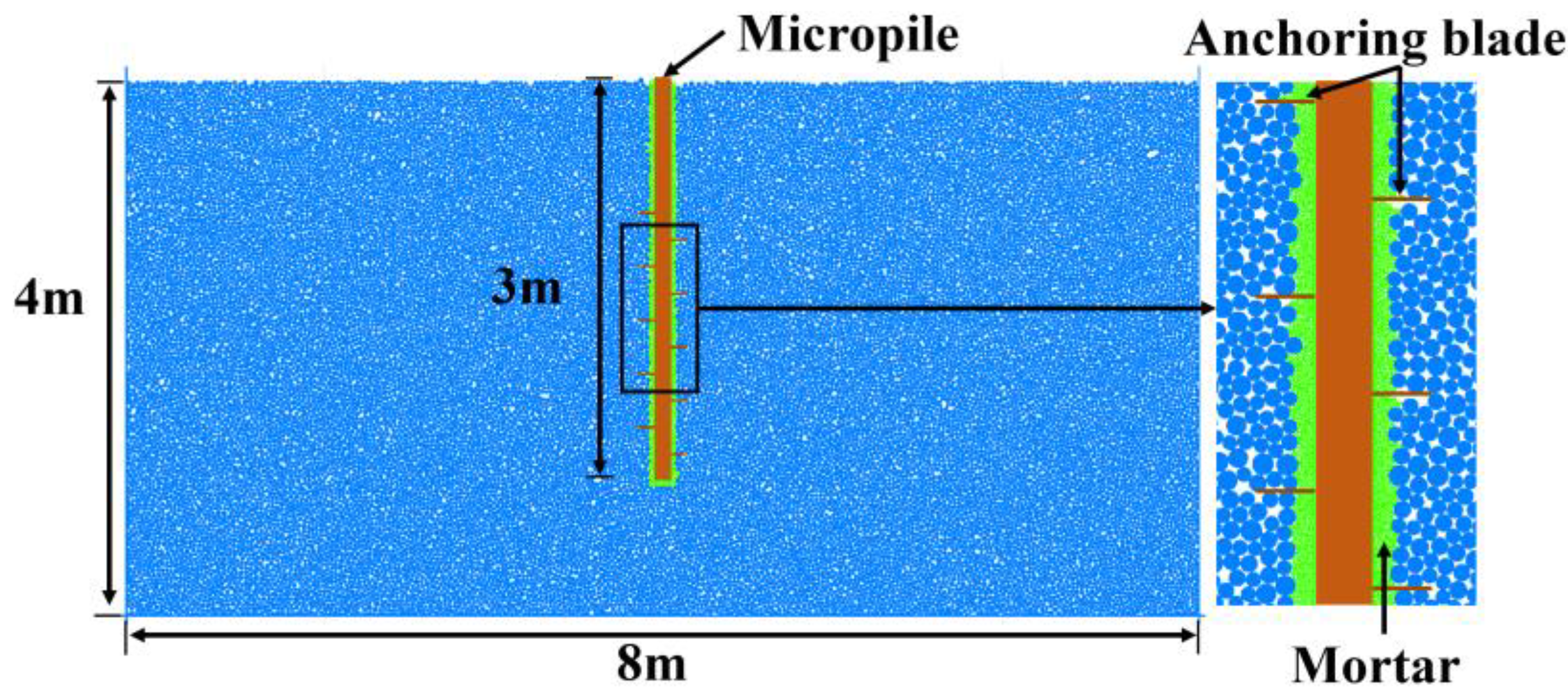
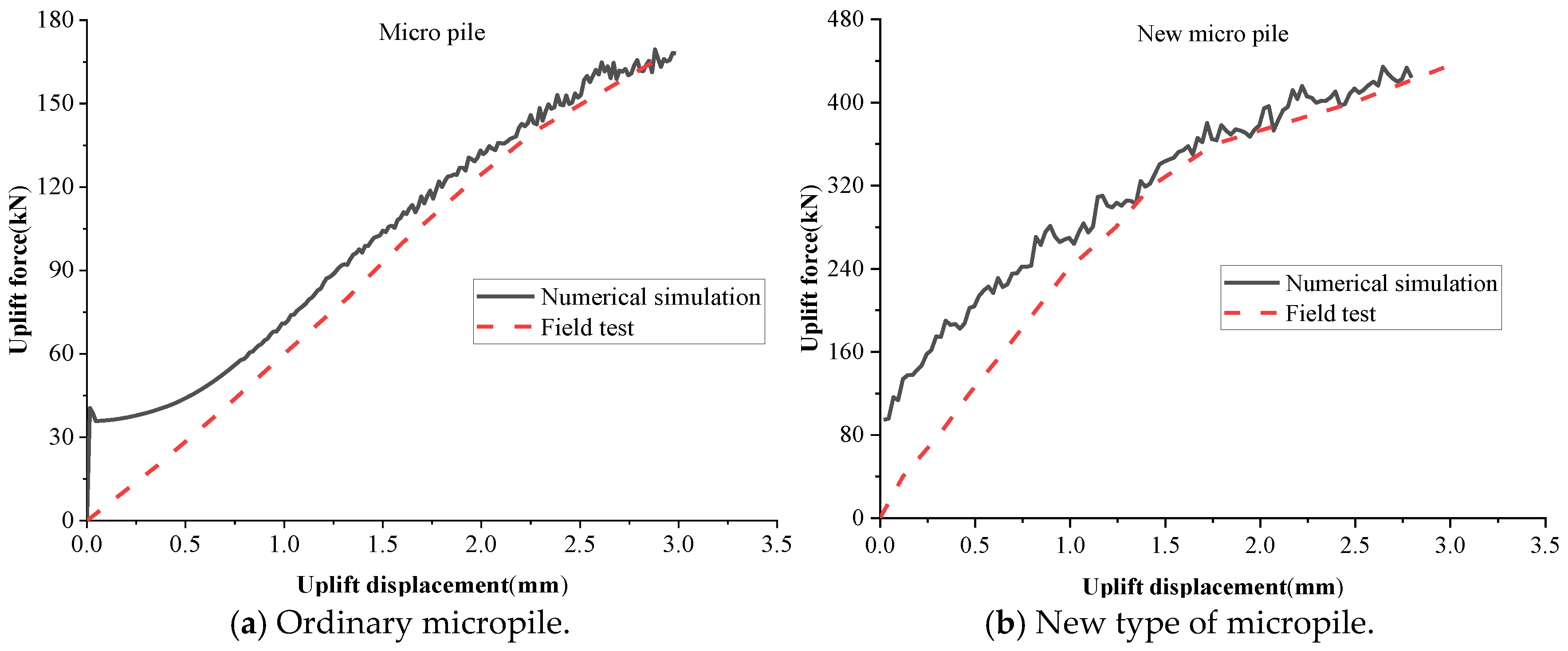



| Natural Density/(g·cm−3) | Natural Moisture Content /% | Cohesion /kPa | Internal Friction Angle/(°) | Specific Gravity | Liquid Limit /% | Plastic Limit /% |
|---|---|---|---|---|---|---|
| 2.0 | 21.2 | 22.9 | 16.3 | 2.69 | 29.8 | 15.6 |
| Microscopic Parameters | Particle Density /(kg·m−3) | Particle Size /m | Porosity | Effective Modulus E/Pa | Stiffness Ratio | Cohesion /N | Coefficient of Friction |
| Soil Body | 2.0 × 103 | 0.016~0.024 | 0.2 | 1.76 × 107 | 1.5 | 1.02 × 103 | 0.2 |
| Grouting Body | 2.5 × 103 | 0.002~0.003 | 0.1 | 2.11 × 108 | 1.5 | 1.24 × 105 | 0.68 |
| Interface | / | / | / | 2.9 × 105 | 1.0 | 1.94 × 103 | 0.55 |
Disclaimer/Publisher’s Note: The statements, opinions and data contained in all publications are solely those of the individual author(s) and contributor(s) and not of MDPI and/or the editor(s). MDPI and/or the editor(s) disclaim responsibility for any injury to people or property resulting from any ideas, methods, instructions or products referred to in the content. |
© 2025 by the authors. Licensee MDPI, Basel, Switzerland. This article is an open access article distributed under the terms and conditions of the Creative Commons Attribution (CC BY) license (https://creativecommons.org/licenses/by/4.0/).
Share and Cite
Wang, H.; Zhang, R.; Liu, Z.; Wang, X.; Zhang, X. Experimental Study on the Uplift Bearing Mechanism of New Pneumatic Pipe Piles. Materials 2025, 18, 1414. https://doi.org/10.3390/ma18071414
Wang H, Zhang R, Liu Z, Wang X, Zhang X. Experimental Study on the Uplift Bearing Mechanism of New Pneumatic Pipe Piles. Materials. 2025; 18(7):1414. https://doi.org/10.3390/ma18071414
Chicago/Turabian StyleWang, Huan, Rui Zhang, Zhengnan Liu, Xiang Wang, and Xiwei Zhang. 2025. "Experimental Study on the Uplift Bearing Mechanism of New Pneumatic Pipe Piles" Materials 18, no. 7: 1414. https://doi.org/10.3390/ma18071414
APA StyleWang, H., Zhang, R., Liu, Z., Wang, X., & Zhang, X. (2025). Experimental Study on the Uplift Bearing Mechanism of New Pneumatic Pipe Piles. Materials, 18(7), 1414. https://doi.org/10.3390/ma18071414






